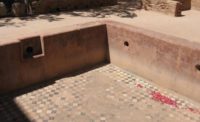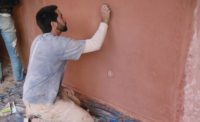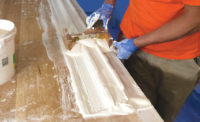Moroccan Aesthetics
A BREAK-DOWN OF MOROCCAN-LIKE PLASTER TAILORED FOR THE U.S. MARKET.










In our two previous articles, Ryan Chivers and I considered the means, methods, and materials of traditional Tadelakt in Morocco, aspects of which extend back to Roman times. Having origins as a practical coating for waterproofing cisterns, the aesthetic qualities of Tadelakt were soon recognized and its use was extended for other wet areas, such as the famous Hammams (public bath houses), private sinks and tubs, as well as an exterior coating for walls to add a bit of luxury for prominent buildings.
Nevertheless, a few obstacles present themselves to traditional Tadelakt application in North America. First, the materials are unique to the Marrakech region of Morocco and have a definite shelf life. Importing the materials is logistically difficult and costly. Additionally, with rare exception we don’t have the same type of monolithic masonry substrates in contemporary construction to work over.
In this concluding article, I’ll review Limestrong, a version of Tadelakt being manufactured in the United States for which means and methods have been developed that ease significantly the application of Tadelakt over a variety of substrates we’re accustomed to encountering.
Materials
The traditional Tadelakt of Marrakech is made from a feebly hydraulic limestone from the nearby Atlas Mountains. The aggregates come from over- or under-burnt particles of the limestone itself. By contrast, Limestrong’s Tadelakt is formulated a little differently by utilizing hydrated lime and blending it with pozzolans of different sizes to give it a comparable performance and aesthetic aspect. Unlike the artisanal Moroccan materials, the carefully monitored domestic manufacture ensures a plaster of consistent quality. Interestingly, whereas in recent times many Moroccan artisans have switched to applying Portland cement basecoats, Limestrong continues to recommend and supply a more traditional lime plaster to serve as a base for their Tadelakt application.
Substrates
With some exceptions in the desert southwest, we rarely encounter the adobe, rammed earth, and earthen plaster substrates typical of Morocco. If the surface to be covered is not in a wet area, drywall may be used and the substrate requirements are the minimal taping, priming, and basecoat you’d expect of many decorative plaster coatings. Wet areas require a bit more attention and preparation. It is important to keep in mind that Tadelakt is not waterproof in and of itself, rather it is the finish of an entire system that provides strong water resistance.
Similar to substrate requirements for tile, cementitious boards affixed to framing that are taped, waterproofed and given a scratch coat of thin-set mortar is a standard preparation. Thereafter, two coats of lime basecoat plaster are applied to a nominal thickness of a 1/4 inch in final preparation for the Tadelakt finish.
Tools & Mixing
The application steps of the base and finish coat have all been adapted to work with the standard tools we have available in North America. Electric drill-type mixers are used to blend up the material in 5-gallon buckets. Materials are best mixed ahead of time to give the pigments opportunity to fully disperse. Basecoats are applied with American rectangular plaster trowels, levelled out with sponge and rubber floats. Finish coats utilize the Swiss INOX stainless steel finish trowels and even plastic autobody filler spreaders for the final stages.
Application
With traditional Tadelakt, the thick earthen substrates have so much suction that you really have to soak the walls extensively. This potentially messy step goes entirely away with Limestrong Tadelakt, which can be applied directly over the lime basecoat. The Tadelakt is applied using a “double-back” or “sweetcoat” technique in up to four successive applications, the last of which is where the plaster should be humid and malleable enough to create a smooth and closed finish, free of any evidence of the trowel.
As the plaster approaches its green stage (no longer wet but not quite dry either), the compressing and burnishing to the surface should commence. This can be done traditionally with an agate stone or for less undulation the autobody filler spreaders can be utilized. Occasionally, ambient conditions will produce uneven drying so some water can be reintroduced as necessary to even things out.
At some point, the Tadelakt will lose any sense of stickiness to the touch. This is the sign to begin the application of a diluted mix of a soap, either the Limestrong proprietary soap or a traditional Moroccan black soap, lightly brushing the soap on while working it in gently with a stone, trowel or spreader. Several applications are critical in achieving a water-resistant finish. Like any lime, it takes about a month to fully carbonate (that is to say cure). For wet areas experiencing regular use, a natural wax is further recommended.
Concluding Thoughts
On a personal note, my wife and I spend a lot of time in Morocco and we love their artisanal traditions and as a plasterer, Tadelakt is certainly near the top of that list. For several years, I had gone through the challenges and frustrations of importing and applying traditional Tadelakt here in the United States. Having worked with the real stuff, I’m so encouraged to finally see in the Limestrong Tadelakt a material that has all of the performance and beauty of Moroccan Tadelakt, while being so well adapted to the tools that are available and the way we build here in North America.
Looking for a reprint of this article?
From high-res PDFs to custom plaques, order your copy today!











